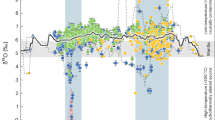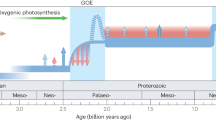Abstract
THE achondrite meteorites known as eucrites and diogenites are thought to be igneous rocks derived from the crust and mantle, respectively, of a common parent planet or asteroid1,2. Several eucrites have been dated at 4.5–4.6 Gyr by the Rb–Sr method4–6, and a Rb–Sr age of 4.45±0.18 Gyr (λ = 1.42x 10−11yr−1) has been reported3 for three diogenites. From these data, one cannot judge whether diogenites and eucrites are the same age. Here we present precise Rb–Sr data for two diogenites (Tatahouine and Johnstown) that yield an age of 4.394 ±0.011 Gyr—significantly younger than our age of 4.52 ±0.15 Gyr for the Juvinas eucrite. The low initial 87Sr/86Sr ratio of these diogenites, and their rare-earth element abundance patterns, are inconsistent with the interpretation that the young ages reflect secondary metamorphism. We suggest that our data raise doubts about a genetically close relationship between eucrites and these diogenites, and that there exist groups of diogenites that are genetically distinct from one another. Our results also suggest that igneous activity in the assumed parent body continued for about one hundred million years after its formation 4.52 Gyr ago. The parent body may thus have had a complicated evolutionary history.
This is a preview of subscription content, access via your institution
Access options
Subscribe to this journal
Receive 51 print issues and online access
$199.00 per year
only $3.90 per issue
Buy this article
- Purchase on Springer Link
- Instant access to full article PDF
Prices may be subject to local taxes which are calculated during checkout
Similar content being viewed by others
References
Mason, B. Am. Sci. 55, 429–455 (1967).
Clayton, R. N., Onuma, N. & Mayeda, T. K. Earth planet Sci. Lett. 30, 10–18 (1976).
Birck, J. L. & Allègre, C. J. Earth planet. Sci. Lett. 55, 116–122 (1981).
Allègre, C. J., Birck, J. L., Fourcade, S. & Semet, M. P. Science 187, 436–438 (1975).
Nyquist, L. E. et al. J. geophys. Res. 91, 8137–8150 (1986).
Birck, J. L. & Allègre, C. J. Earth planet. Sci. Lett. 39, 37–51 (1978).
Takeda, H. & Mori, H. Meteoritics 16, 390–391 (1981).
Consolmagno, G. J. Icarus 70, 522–530 (1979).
Papanastassiou, D. A. & Wasserburg, G. J. Earth planet. Sci. Lett. 5, 361–376 (1969).
Author information
Authors and Affiliations
Rights and permissions
About this article
Cite this article
Takahashi, K., Masudat, A. Young ages of two diogenites and their genetic implications. Nature 343, 540–542 (1990). https://doi.org/10.1038/343540a0
Received:
Accepted:
Issue Date:
DOI: https://doi.org/10.1038/343540a0
Comments
By submitting a comment you agree to abide by our Terms and Community Guidelines. If you find something abusive or that does not comply with our terms or guidelines please flag it as inappropriate.



